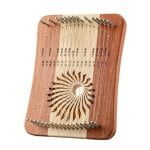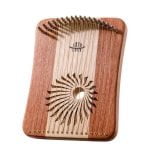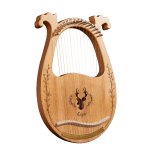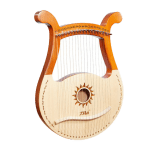When the hands play the lyre harp with skill, it creates a magnificent tone. The instrument is stunning and majestic. However, when playing the harp lyre, is it better to use both hands or just one? This article will contrast the methods and advantages of playing the lyre harp with one hand versus two hands.

The history of the lyre harp
First, a brief history. The lyre originated in Mesopotamia over 5000 years ago! This ancient stringed instrument was played by plucking the strings with one hand while strumming rhythms with the other. Later lyres like the Greek kithara featured a large wooden body with arms projecting from the soundbox. These elaborate lyres required two-handed playing techniques.
Over the centuries, the lyre evolved into the modern harp lyre we know today. Contemporary lyres encompass a family of small personal harps with various numbers of strings. Their portable size and melodic voice makes them a popular folk instrument. Now let’s look at how hand positioning affects technique and sound.
Playing the lyre harp with one hand
The most straightforward way to play the lyre is to pluck the strings using just your dominant hand. With a simple 7 or 8 string lyre, you can easily access all notes with one hand. Rest the base of the lyre harp against your shoulder and use your thumb, index, and middle fingers to pluck. Your wrist, thumb, and finger motions will create different articulations.
One-handed playing allows you to hold a microphone or sheet music in your non-dominant hand. It also leaves a hand free for strumming, drumming, or percussion. Beginners will find this monophonic playing style the easiest to learn. But using one hand limits the notes, chords, and techniques possible.
Unlocking the two-handed lyre sound
While one hand works for simple melodies, using both hands opens up more musical possibilities. Two-handed technique allows you to play chords, layered rhythms, and arpeggios. Your non-dominant hand provides stability while the dominant hand plucks patterns.
Having both hands in action multiplies the tones sounding together. Two hands give you access to chord voicings up and down the harp lyre’s string scale. You can also use one hand to hold drones or ostinatos while the other plays fast runs and ornaments. Mastering two-handed skills takes practice but creates a richer musical experience.
Hand position and posture
Proper hand position and posture is key to balancing the lyre and producing clear tone. Here are some tips:
– Hold the lyre harp upright, positioned near your shoulder. Keep your back straight.
– Let the lyre rest on your non-dominant shoulder. Stabilize it with your non-dominant hand.
– Keep both wrists loose and supple for fluid plucking motion. Avoid tense movements.
– Use a light plucking touch, allowing the strings to vibrate openly.
– For full chords, flatten fingers across multiple strings.
– Try different thumb and finger patterns to pluck multiple notes.
Two-handed techniques to try
Here are some two-handed lyre techniques to explore:
– Strumming – Use your non-dominant hand to strum rhythmic patterns. Add fingerpicks for a sharper attack.
– Chords – Play 3-4 note chords to support melodies and harmonize.
– Arpeggios – Pluck chord tones separately in sequence to create cascading effects.
– Counterpoint – Have each hand play independent but complementary lines that interweave.
– Drone – Hold a stationary tonic or 5th with one hand while the other plays melodies.
– Tremolo – Rapidly repeat a note using alternating finger motion to create a shimmer.
– Accompaniment – Include chords, basslines, and rhythms to build arrangeme.















